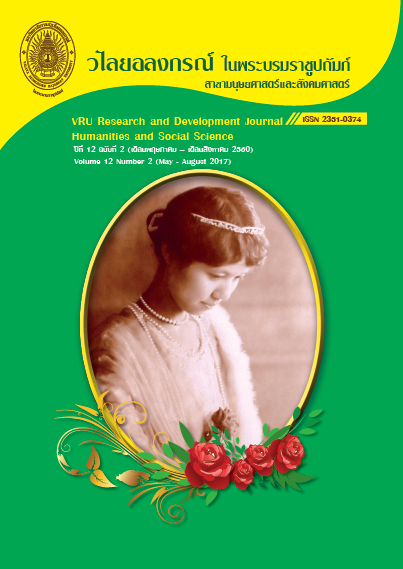ปัจจัยความสำเร็จของการตลาดเชิงสัมพันธ์ในอุตสาหกรรมท่องเที่ยว
Main Article Content
Abstract
การรักษาลูกค้าจะคุ้มค่ามากขึ้นกว่าการได้ลูกค้าใหม่ นอกจากนี้การรักษาความสัมพันธ์ที่ดีกับลูกค้าเดิมและการได้รับคุณค่าชีวิตที่ดีของลูกค้าปัจจุบัน เป็นกุญแจสู่ความสำเร็จในระยะยาวของธุรกิจ การตลาดเชิงสัมพันธ์ใช้เพื่อสร้างความสัมพันธ์ระยะยาวกับลูกค้าเพื่อให้ลูกค้าสร้างความผูกพันระยะยาวกับบริษัท และตราสินค้า สิ่งนี้จะเป็นประโยชน์ต่อองค์กรในการทำกำไร การบอกต่อ และประสิทธิภาพโดยรวมของบริษัท การตลาดเชิงสัมพันธ์ไม่ใช่เรื่องง่ายเพราะลูกค้าแต่ละรายมีความแตกต่างกันและเมื่อคิดค้นกลยุทธ์การตลาดเชิงสัมพันธ์ บริษัทต้องพิจารณาฐานลูกค้าที่มีอยู่อย่างพิถีพิถัน กุญแจสู่ความสำเร็จของการตลาดเชิงสัมพันธ์คือ การทำความเข้าใจลูกค้าขององค์กรอย่างครบถ้วนสมบูรณ์ โดยปัจจัยแห่งความสำเร็จนั้นประกอบด้วย เทคโนโลยีสารสนเทศ การตลาดทางตรง การมอบประโยชน์แก่ลูกค้า วัฒนธรรมองค์กร และการจัดการลูกค้าสัมพันธ์ ซึ่งปัจจัยดังกล่าวต้องผสานเป็นหนึ่งเดียวในการให้บริการลูกค้า
Retaining a customer is much more cost effective than acquiring a new customer. Furthermore, maintaining good relations with your existing customers and getting a good life time value out of any existing customer is the key to a long term successful business. Relationship marketing is used to forge long term relationships with the customer such that the customer forms a long term bond with the company and the brand. This in turn benefits the organization in turnover, profitability, word of mouth publicity and overall performance. Relationship marketing is not easy because each and every customer is different and when devising a relationship marketing strategy, the firm has to look at its existing customer base minutely. The key to success of relationship marketing is to understand your customer completely. Factors of success include: information technology, direct marketing, customer benefits, organisation culture and customer relationship management. These factors must be integrated into customer service
Article Details
ลิขสิทธิ์บทความวิจัยที่ได้รับการตีพิมพ์เผยแพร่ในวารสารมนุษยศาสตร์และสังคมศาสตร์ วไลยอลงกรณ์ ในพระบรมราชูปถัมภ์ ถือเป็นกรรมสิทธิ์ของคณะมนุษยศาสตร์และสังคมศาสตร์ มหาวิทยาลัยราชภัฏวไลยอลงกรณ์ ในพระบรมราชูปถัมภ์ ห้ามนำข้อความทั้งหมดหรือบางส่วนไปพิมพ์ซ้ำ เว้นแต่จะได้รับอนุญาตจากมหาวิทยาลัยเป็นลายลักษณ์อักษร
ความรับผิดชอบ เนื้อหาต้นฉบับที่ปรากฏในวารสารมนุษยศาสตร์และสังคมศาสตร์ วไลยอลงกรณ์ ในพระบรมราชูปถัมภ์ เป็นความรับผิดชอบของผู้นิพนธ์บทความหรือผู้เขียนเอง ทั้งนี้ไม่รวมความผิดพลาดอันเกิดจากเทคนิคการพิมพ์
References
Chaffey D, Mayer R, Johnston K and Ellis C. F. (2000). Internet Marketing. Pearson Education, Harlow.
Chung, Y.C., Hsu, Y.W., Tsai, S.C., Huang, H.L., and Tsai, C.H. (2012). The correlation between business strategy, information technology, organizational culture, implementation of CRM, and business performance in a high-tech industry. South African Journal of Industrial Engineering, (23)2:1-15
Dahl, D. W., Heather H., and Rajesh V. M. (2005). Three Rs of Interpersonal Consumer Guilt: Relationship, Reciprocity, Reparation. Journal of Consumer Psychology, 15 (4), 307–315.
Egan, J. (2011). Relationship Marketing. (4th ed.,) Prentice Hall. England.
Goei, R. and Boster, F., (2005). The roles of obligation and gratitude in explaining the effect of favors on compliance. Communication Monographs, 72(3), 284-300.
Goldsmith, R.E. (2010). Consumer attitudes and loyalty towards private brands. International Consumer Studies, 34, 3: 339–348
Grönroos, C. (2000). Service Management and Marketing: A Customer Relationship Management Approach. Wiley & Sons, Inc., New York, NY.
Iriana, R., Buttle, F., and Ang, L. (2013). Does organizational culture influence CRM's financial outcomes?. Journal of Marketing Management, 29)3/4:467-493
Johnston R. and Clark G., (2001). Service Operation Management, Prentice Hall, London.
Kelly, S. (2000). Analytical CRM: the fusion of data and intelligence. Interactive Marketing, (3), 262-267.
Kotler, P. and Keller, K. L., (2006). Marketing Management. (12th ed.). Upper Saddle River, New Jersey: Pearson Prentice Hall.
Kotler P., Bowen J. and Makens J., (2013). Marketing for Hospitality and Tourism. (6th ed.). Prentice Hall, New Jersey.
McConnell and Huba, (2003). Creating Customer Evangelists: How Loyal Customers Become a Volunteer Sales force. Chicago, Dearborn Trade Publishers.
Maja C. and Milenko D. Djuric, (2009). Relationship Marketing in The Tourist Services Sector. UTMS Journal of Economics, Vol. 1, No. 1, pp. 53-60.
Morales, A. C. (2005). Giving Firms an ‘E’ for Effort: Consumer Responses to High-Effort Firms. Journal of Consumer Research, 31 (March), 806–812.
Nagasimha K. (2000). Role of Relationship Marketing in Competitive Marketing Strategy. Journal of Management and Marketing Research.
Nwakanma H., Jackson, A. S. and Burkhalter J. N. (2007). Relationship Marketing: An Important Tool For Success In The Marketplace. Journal of Business & Economics Research, 5/2: 55-64.
Palmatier, R. W., Rajiv P. Dant, and Dhruv G. (2007). A Comparative Longitudinal Analysis of Theoretical Perspectives of Interorganizational Relationship Performance. Journal of Marketing, 71 (October), 172–94.
Srivastava, S., John, O. P., Gosling, S. D., & Potter, J. (2003). Development of personality in early and middle adulthood: Set like plaster or persistent change? Journal of Personality and Social Psychology, 84, 1041-1053.
Stein, A., and Smith, M. (2009). CRM systems and organizational learning: An exploration of the relationship between CRM effectiveness and the customer information orientation of the firm in industrial markets. Industrial Marketing Management, 38(2):198-206
Tsang, Jo-Ann. (2006). The Effects of Helper Intention on Gratitude and Indebtedness. Motivation & Emotion, 30 (September), 199–205.
Young, L. (2006). Trust: Looking Forward and Back. Journal of Business & Industrial Marketing, 21 (7), 439–45.

